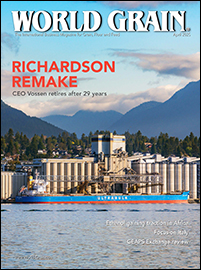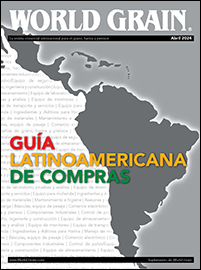Malaysia is a major producer of palm oil. It produces no wheat and little maize and needs to make up a shortfall in rice with imports. Maize and wheat are imported to feed livestock, while demand for wheat-based products is growing and the country does have a significant flour milling industry.
The International Grains Council (IGC) puts Malaysia’s total grain imports at 4.5 million tonnes in 2013-14, compared with 4.1 million the year before. The total includes 1.4 million tonnes of wheat, up from 1.3 million the year before, and 3.1 million tonnes of maize, up from 2.8 million the prior year.
It puts Malaysia’s rice imports in 2013-14 at 1.1 million tonnes, up from 1 million the year before. The country is also slated to import 1.4 million tonnes of soymeal in 2013-14.
Malaysia is a massive producer of palm oil. According to the USDA attaché, production in the 2013-14 marketing year, which began in October 2013, will total 19.2 million tonnes, down from 19.321 million the year before, with exports at 17.75 million tonnes, down from 18.44 million the prior year.
The attaché, in 2013’s annual report on the grains sector, described maize production as “insignificant.” “With a continued robust economy, demand for poultry meat in Malaysia remains firm, which underpins feed grain demand,” it said. “As consumers’ demand for both pork and broiler meat grows, corn consumption is forecast to increase marginally in 2013-14.”
In the 2014 report, which appeared in February, the attaché predicted only a small rise in maize imports, to 3.2 million tonnes in 2014-15, from 3.15 million the year before. “Pork production is not growing,” the report said. “Although the Government of Malaysia has reduced consumer subsidies for some products and services, poultry meat remains the key protein source, and while not growing strongly, demand remains firm. Lower corn prices will be beneficial to the poultry sector in 2014, and will result in some increase in demand.”
“Argentina is still the dominant supplier with over 40% market share, followed by India and Brazil,” the report said. “The freight disadvantage hinders U.S. sales. U.S. DDGS sales to Malaysia continue to grow, reaching 62,000 tonnes in 2012. Feed compounders are becoming increasingly familiar with the product and are showing a growing willingness to increase usage rates in feed rations.”
The same report was blunt about wheat. “Wheat is not produced in Malaysia,” it said.
Malaysians are, however, consuming more wheat-based products. “In line with the growth in consumer demand, interest in good quality pastries and bread is rising, and the number of specialties cafes and pastry shops serving bakery products is similarly increasing,” the report said. “More consumers are opting for high-fiber whole meal bread. In addition, instant noodles and sweet biscuits manufacturing for both domestic and export markets is growing.”
The attaché explained that the government controls domestic wheat prices for low-income customers. The price of wheat flour for industrial uses is not controlled. “When necessary, the Government of Malaysia has given subsidies to the bread industry in order to alleviate declining margins caused by any increase in wheat prices,” the report said.
“Prices for domestic consumption flour have been set by the government since May 14, 2007 RM1.35 ($0.45) per kilo. Reportedly, the government is considering reducing or lowering the subsidy required to maintain this price. Australia remains the biggest exporter to Malaysia, holding about a 60% market share. Imports from non-traditional suppliers such as Pakistan, Russia and Ukraine have been increasing.”
Rice production grows
According to the attaché’s 2014 annual report, Malaysia will produce 1.8 million tonnes of rice on a milled production basis in 2014-15, with the marketing year beginning on Jan. 1, 2015. The previous year’s production was 1.755 million tonnes.
“Improvements in irrigation, increased planted area in East Malaysia, better management, and the use of high-yielding paddy varieties is expected to lead to improved overall production in 2014,” the attaché said. “Another slight increase is forecast for 2015, but land limitations preclude significant expansion.”
Improving rice yields continues to be a major priority for Malaysia, the report said. “Government of Malaysia support is provided via guaranteed purchase prices and provision of subsidized seeds, fertilizer, and other inputs,” it said. “In January 2014, the government set the support price for paddy at RM1,200 per tonne. While the government has given up on full self-sufficiency, reducing reliance on rice imports continues to be of strategic importance.”
Palm oil
According to the Malaysian Palm Oil Board’s Economics and Industry Development Division, the industry’s performance in 2013 was mixed with increased production of crude oil and increased export demand, while exports were low.
“The oil palm planted area in 2013 reached 5.23 million hectares, an increase of 3% as against 5.08 million hectares recorded in the previous year,” it said in a report on the year. “This was mainly due to the increase in new planted area in Sarawak, which recorded an increase of 7.9% or 84,660 hectares. Sabah is still the largest oil palm planted state, with 1.48 million hectares or 28% of total oil palm planted area, followed by Sarawak with 1.16 million hectares or 22%, while Peninsular Malaysia accounted for 2.59 million hectares or 50%.”
Exports of palm oil increased by 3.1% to 18.12 million tonnes. China remains the biggest customer, taking 20.4% of Malaysia’s exports followed by the E.U. and India.
“In 2013, CPO price showed an upward trend as a result of the government’s measure to restructure the CPO export duty,” the report said. Prices in December were “mainly supported by higher export performance during the third quarter of the year and concerns over palm oil supply disruption as a result of the monsoon season in the East Coast of Malaysia.
“The super typhoon Haiyan in the Philippines that could tighten coconut oil supplies and the possible shifting demand to palm oil-based substitutes added to the positive price sentiment,” it said.
Flour milling
The Star newspaper described the Malaysian flour milling industry in a feature published in December.
“As of 2013, there are no less than 14 flour mills in the country importing some 1.5 million tonnes of wheat yearly,” said writer Grace Chen. “Nationwide, Malaysians now consume 960,000 tonnes of wheat flour per year.”
“From this figure, 270,000 tonnes for the consumer flour industries will come from Interflour Malaysia,” she said. “As one of the largest flour millers in Southeast Asia, the company’s four mills have a production capacity of 1,800 tonnes of wheat per day.”
In interview with Interflour Holdings Malaysia Chief Executive Officer Alex Lee, the paper reported that a new mill expansion in Pasir Gudang, Johor, with completion expected sometime in the first half of 2015, will increase the production capacity by 500 tonnes per day.
Struggling biodiesel sector
“Faced with sluggish domestic demand, and stiff competition from Indonesia in export markets, Malaysia’s biodiesel sector continues to struggle,” the attaché said in a report on biofuels. “Nonetheless, the government has pledged to continue supporting the sector, and seeks to complete implementation of a 5% blend, followed by a 10% blend in 2014. The dominant objective of the program continues to be to boost demand for crude palm oil.”
The biotechnology industry is also facing challenges.
“No GE crops are approved for planting in Malaysia,” the attaché said, although it noted in a report from July 2013 that trials of a biotech-based papaya had recently been approved. “Only a few corn and soybean GE events have been authorized for release on the market, even though approval is technically required for food, feed, and processing,” the report said. “The local food processing sector is quite concerned about the slow pace of approvals, as the 3.6 million tonnes of annual corn and soybean imports undoubtedly include unapproved GE varieties. Recently published GE labeling guidelines will be enforced starting in July 2014.”
Key Facts
Capital: Kuala Lumpur
Population: 29,628,392 (July 2013 est.)
Religions: Muslim (or Islam - official) 60.4%, Buddhist 19.2%, Christian 9.1%, Hindu 6.3%, Confucianism, Taoism, other traditional Chinese religions 2.6%, other or unknown 1.5%, none 0.8% (2000 census).
Location: Southeastern Asia, peninsula bordering Thailand and northern one-third of the island of Borneo, bordering Indonesia, Brunei, and the South China Sea, south of Vietnam.
Government: Constitutional monarchy. Chief of state: King Tuanku Abdul Halim Mu’adzam Shah (since Dec. 13, 2011); head of government: Prime Minister Mohamed Najib bin Abdul Najib Razak (since April 3, 2009).
Economy: Malaysia, a middle-income country, has transformed itself since the 1970s from a producer of raw materials into an emerging multi-sector economy. Under current Prime Minister NAJIB, Malaysia is attempting to achieve high-income status by 2020 and to move farther up the value-added production chain by attracting investments in Islamic finance, high technology industries, biotechnology, and services. NAJIB’s Economic Transformation Program (ETP) is a series of projects and policy measures intended to accelerate the country’s economic growth. The government has also taken steps to liberalize some services sub-sectors. The NAJIB administration also is continuing efforts to boost domestic demand and reduce the economy’s dependence on exports. Nevertheless, exports — particularly of electronics, oil and gas, palm oil and rubber — remain a significant driver of the economy. As an oil and gas exporter, Malaysia has profited from higher world energy prices, although the rising cost of domestic gasoline and diesel fuel, combined with strained government finances, has forced Kuala Lumpur to begin to reduce government subsidies. Bank Negera Malaysia (central bank) maintains healthy foreign exchange reserves, and a well-developed regulatory regime has limited Malaysia’s exposure to riskier financial instruments and the global financial crisis. Nevertheless, Malaysia could be vulnerable to a fall in commodity prices or a general slowdown in global economic activity because exports are a major component of GDP. In order to attract increased investment, NAJIB has raised possible revisions to the special economic and social preferences accorded to ethnic Malays under the New Economic Policy of 1970, but he has encountered significant opposition, especially from Malay nationalists and other
vested interests.
GDP per capita: $16,800 (2012 est.); inflation: 1.7% (2012 est.); unemployment: 3% (2012 est.).
Currency: Ringgit (MYR): 3.29 ringgits equal 1 U.S. dollar (Feb. 21, 2014).
Exports: $227.7 billion (2012 est.): semiconductors and electronic equipment, palm oil, petroleum and liquefied natural gas, wood and wood products, palm oil, rubber, textiles, chemicals, solar panels.
Imports: $186.9 billion (2012 est.): electronics, machinery, petroleum products, plastics, vehicles, iron and steel products, chemicals.
Major crops/agricultural products: Peninsular Malaysia — palm oil, rubber, cocoa, rice; Sabah — palm oil, subsistence crops; rubber, timber; Sarawak — palm oil, rubber, timber; pepper.
Agriculture: 11.4% of GDP and 11.1% of the labor force.
Internet: Code: .my; 422,470 (2012) hosts and 15.355 million (2009) users.
Source: CIA World Factbook





